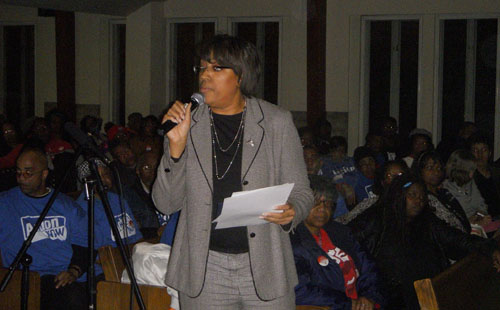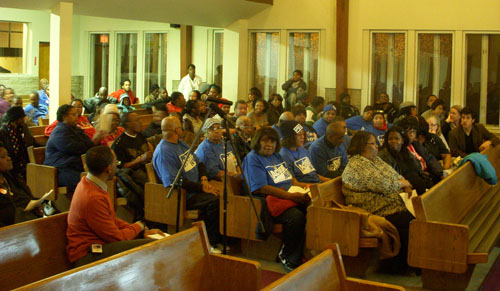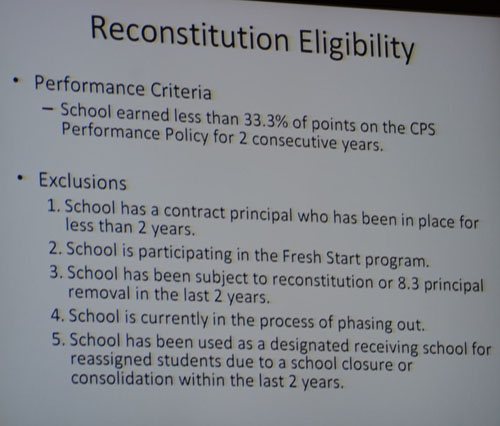Disruption caused by multiple principals cited as undermining school... Majority at Guggenheim Elementary hearing mostly in opposition to proposed closing
On Friday, January 6, 2012 about a hundred people met in the Shiloh Baptist church, 7050 S. Racine, as part of CPS’ hearings on the closing of Guggenheim Elementary. This meeting was one of the hearings held on Friday, virtually all of them away from the schools that were to be affected by the CPS policy. In the crowd of people, were all the concerned parties, community members, teachers, parents, students and CPS bureaucrats — including the "Chief of Schools" for Englewood- Gresham, Adrian Willis.
 Alderman Latasha Thomas (above) was one of those who spoke against the closing of Guggenheim Elementary School at the hearing on January 6, 2012. Many asked why the hearing was held at the Shiloh Baptist Church instead of a the school itself. Substance photo by Al Ramirez.Teachers and parents have been noting that the disruption of Guggenheim caused by the change of administration at the school would have eliminated the school from consideration for closing in previous years. But apparently that is not the case this year. The controversial new principal and assistant principal of Guggenheim were not in attendance.
Alderman Latasha Thomas (above) was one of those who spoke against the closing of Guggenheim Elementary School at the hearing on January 6, 2012. Many asked why the hearing was held at the Shiloh Baptist Church instead of a the school itself. Substance photo by Al Ramirez.Teachers and parents have been noting that the disruption of Guggenheim caused by the change of administration at the school would have eliminated the school from consideration for closing in previous years. But apparently that is not the case this year. The controversial new principal and assistant principal of Guggenheim were not in attendance.
When it came time for the public portion of the meeting, the first five or six speakers spoke or read from a piece of paper, in favor of the Board’s proposal of closing the school. Substance staff have noted similar prepared statements from people brought to meetings since the hearings at Westinghouse and Simeon on the proposed "guidelines" two months ago.
It soon became clear, however, that the majority of the school and community were organized against the latest CPS attack on the schools. The majority of the remaining twenty plus speakers, — who included Matt Luskin, an organizer of CTU; members of Action Now; and the neighborhood’s Alderman, Latasha Thomas — spoke against the proposal.
 Above, some of the nearly 100 people who turned out for the hearing on the proposal to close Guggenheim Elementary School on January 6, 2012. Substance photo by Al Ramirez.The meeting was held without incident, although there were as many as four CPS security at the ready positioned around the church.
Above, some of the nearly 100 people who turned out for the hearing on the proposal to close Guggenheim Elementary School on January 6, 2012. Substance photo by Al Ramirez.The meeting was held without incident, although there were as many as four CPS security at the ready positioned around the church.
When asked about the hearing being held at Shiloh Baptist and not in Guggenheim’s building, Mr. Smith, Guggenheim’s Security guard, said “I was wondering the same thing”. Guggenheim’s next hearing will be on January 20th — at the same location at the same time unless CPS decides to save the money it must have spent renting the church and holds the meeting at Guggenheim, which was the site of meetings a year ago.
This year, six elementary schools are slated for closing in June 2012 under the latest (and tenth or eleventh) version of CPS guidelines for closing, consolidation, and phase out. They are six elementary schools — Doolittle East Elementary, Guggenheim Elementary, Lathrop Elementary, Nash Elementary, Price Elementary, Reed Elementary — and four high schools — Austin HS, Best Practice HS, Crane HS, and Dyett HS.
 Less than two years after protests and a candlelight vigil thwarted a proposal by then "Chief Executive Officer" Ron Huberman to close Guggenheim Elementary School, CPS, under another CEO (Jean-Claude Brizard) has again put Guggenheim on the Hit List. Above, teachers from Guggenheim and members of CORE in the Guggenheim gym on February 4, 2010, the night of the candlelight vigil protesting the Hit List attack on Guggenheim. Three of those in the above photograph (Karen Lewis, Kristine Mayle, and Jesse Sharkey) were elected officers of the Chicago Teachers Union a few months after they participated in the Guggenheim and other protests against the Huberman/Daley hit list in 2010. Substance photo.Every one of the schools slated for closing by the administration of CPS under the latest CPS "Chief Executive Officer," Jean Claude Brizard and the Board of Education (all appointed by Mayor Rahm Emanuel) is located in Chicago's African-American community.
Less than two years after protests and a candlelight vigil thwarted a proposal by then "Chief Executive Officer" Ron Huberman to close Guggenheim Elementary School, CPS, under another CEO (Jean-Claude Brizard) has again put Guggenheim on the Hit List. Above, teachers from Guggenheim and members of CORE in the Guggenheim gym on February 4, 2010, the night of the candlelight vigil protesting the Hit List attack on Guggenheim. Three of those in the above photograph (Karen Lewis, Kristine Mayle, and Jesse Sharkey) were elected officers of the Chicago Teachers Union a few months after they participated in the Guggenheim and other protests against the Huberman/Daley hit list in 2010. Substance photo.Every one of the schools slated for closing by the administration of CPS under the latest CPS "Chief Executive Officer," Jean Claude Brizard and the Board of Education (all appointed by Mayor Rahm Emanuel) is located in Chicago's African-American community.
As critics have pointed out for several years, Chicago's black schools and black teachers have borne the majority of the closings and "turnarounds" that began in the late 1990s, when Richard M. Daley was Mayor of Chicago and Paul G. Vallas was CEO of CPS. Second on the Hit Lists (as critics have called the closings each year) were schools in Chicago's Latino communities. Very few white children have been affected by the closings, and this year not one school on the Hit List is from the part of the city north of Chicago Ave. Although white teachers and other staff have lost their jobs and had their careers destroyed since the closings and turnarounds escalated since the beginning of the 21st Century, they were a minority of those affected by the policies. Closings usually result in the elimination of teachers and other staffs from the schools, just as the so-called "turnarounds" result in the firing of all the staff at the schools (including lunchroom workers and janitors) under policies that were perfected between 2002 and 2008, when Arne Duncan was CEO of CPS.
 Looking back at 2010 Hit List, anyone can see how facts are manipulated by CPS officials. Despite claims that its "criteria" for developing the annual Hit List is somehow scientific, "data-driven," and ostensibly objective, the actual history of the attacks on Chicago public schools since they began under former Mayor Richard M. Daley and former Schools CEO Paul G. Vallas in the 1990s show that the "data" presented are often slanted against the schools, the hearings are rubber stamps for what is in fact a "done deal," and the members of the Board are there to rubber stamp ruling class privatization policy no matter what is in the interest of the children of the community and not matter what they facts are. Above, one of the slides utilized in January and February 2010 at the hearings held then on the Hit List proposed by former Chicago police officer Ron Huberman, who was at that time CEO of CPS. Substance photo by George N. Schmidt.Many of the buildings that have been closed by CPS eventually are turned over to privatized charter schools, which CPS rents to charter organizations, usually for $1 per year.
Looking back at 2010 Hit List, anyone can see how facts are manipulated by CPS officials. Despite claims that its "criteria" for developing the annual Hit List is somehow scientific, "data-driven," and ostensibly objective, the actual history of the attacks on Chicago public schools since they began under former Mayor Richard M. Daley and former Schools CEO Paul G. Vallas in the 1990s show that the "data" presented are often slanted against the schools, the hearings are rubber stamps for what is in fact a "done deal," and the members of the Board are there to rubber stamp ruling class privatization policy no matter what is in the interest of the children of the community and not matter what they facts are. Above, one of the slides utilized in January and February 2010 at the hearings held then on the Hit List proposed by former Chicago police officer Ron Huberman, who was at that time CEO of CPS. Substance photo by George N. Schmidt.Many of the buildings that have been closed by CPS eventually are turned over to privatized charter schools, which CPS rents to charter organizations, usually for $1 per year.


By: Jean Schwab
Meeting at the neighborhood School
I know why the meetings are being held at sites other than the school. Holding meetings off-site make people step back and become an observer -not involved in the process. Buildings have an emotional pull on people. I never went to Stagg as a student but by going through the building I felt part of it all. I didn't want that school to close. Standing outside of Marquette I felt all the people that had been educated there and their desire not to have it closed or turned over to someone else. I never went to either school or lived in the neighborhood but I felt it. How much more do the people that actually live there feel? That is a mind game played by the board. They are cruel and uncaring- at least let the people meet and fight for their school in their school. I live near Humbolt, Moos,Casals,Clemente, Yates and Chase. My children and grandchildren attended Moos,Clemente and Yates.
I have a connection to all of these schools.